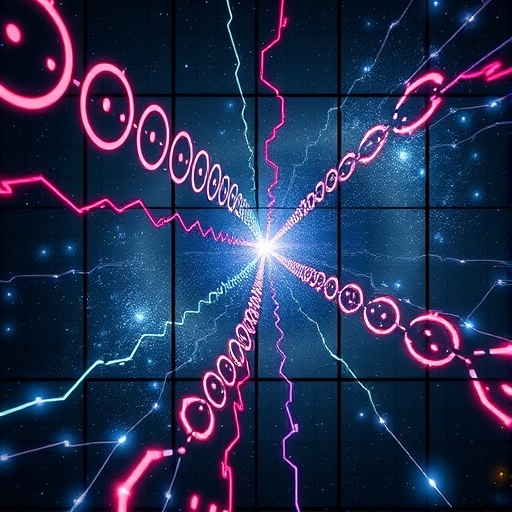In a groundbreaking analysis that challenges prevailing assumptions in foundational physics, recent research reveals that classical theories of gravity may indeed produce entanglement—a quantum phenomenon previously thought to be an exclusive hallmark of quantum gravity. This paradigm-shifting insight comes from a study meticulously dissecting the interaction between mass, time duration of experiments, and the resulting gravitational effects, presenting profound implications for the interpretation of entanglement observations and the ongoing quest to confirm the quantum nature of gravity.
At the heart of this study is the delicate balance between mass and timescales within experimental setups designed to probe gravitational interactions at quantum levels. Historically, works inspired by Feynman’s thought experiments have proposed a range of masses—from minute scales on the order of 10⁻¹⁴ kilograms up to the Planck mass (~10⁻⁸ kg)—paired with varying coherence durations to maximize sensitivity to quantum gravity effects. Larger masses promise amplified gravitational effects but typically require shorter interaction times to mitigate decoherence, while smaller masses demand prolonged coherence times and sizable spatial superpositions, a feat challenged by environmental perturbations.
The researchers underscore a particularly thorny issue: decoherence induced by residual gas scattering in vacuum chambers. This mechanism scales linearly with environmental pressure and sublinearly with mass, specifically following an M^{2/3} dependence, a much weaker influence compared to the M² scaling of the quantum gravity effect parameter φ. To suppress decoherence sufficiently for small masses at long interaction times—such as a 2-second duration with a mass around 10⁻¹⁴ kg—ultra-high vacuum conditions as extreme as 10⁻¹⁵ pascals are required, posing daunting experimental barriers. Consequently, experimental designs exploring larger masses with shorter durations, potentially as brief as microseconds, emerge as pragmatically advantageous approaches, with masses ranging from picograms to grams under consideration.
A pivotal contribution of this work lies in the detailed comparison between classical and quantum gravitational effects, denoted ϑ and φ, respectively. Using ytterbium-based experimental models, the analysis reveals that for smaller masses and long durations, the quantum gravity signal φ outstrips the classical gravity effect ϑ, seemingly aligning with traditional expectations. However, intriguingly, as masses approach—and even exceed—the Planck mass, classical gravitational interactions yield sizable entanglement (ϑ ~ 0.1), even in fleeting experimental windows. This classical gravitational entanglement complicates the once straightforward interpretative framework where any detected entanglement would automatically indicate quantum gravity.
This subtle but profound nuance arises from the underlying physics: the entanglement generated in gravitational experiments may stem not solely from quantized gravitational fields but also from the quantum characteristics of matter fields within classical gravitational backgrounds. The exchange of virtual quantum matter associated with gravitational interactions can produce entanglement independently of whether gravity itself is fundamentally quantum. This realization cautions against oversimplified conclusions and indicates that the presence of entanglement alone does not unambiguously discriminate between classical and quantum gravitational theories.
Furthermore, the study highlights the analogy with electromagnetism, where classical electromagnetic fields and quantum electrodynamics both enable entanglement generation through exchanges of virtual photons or classical Coulomb fields, respectively. If electromagnetism were classical, entanglement could arise under similar mechanisms as gravitational entanglement under classical gravity coupled with quantum matter—illustrating the nuanced complexities in interpreting experimental outcomes that aim to prove the quantum nature of fundamental forces.
The implications for experimental physics are both challenging and invigorating. To unambiguously demonstrate quantum gravity, experiments must not only detect entanglement but must operate within parameter regimes where the classical gravitational contribution to entanglement is negligible. According to the study, this requires maintaining experimental conditions to the left of a critical line on the mass-duration phase space where ϑ falls below thresholds associated with significant classical entanglement influences.
Another layer of complexity arises from practical experimental concerns, such as achieving and sustaining superposition sizes required to maximize sensitivity to gravity’s quantum aspects. Large spatial superpositions remain difficult to realize experimentally, prompting considerations of smaller superpositions balanced with optimized mass and coherence times. The interplay of geometry—specifically the separation distances relative to object sizes and superposition distances—also factors into the strength and detectability of gravitational interactions.
In summation, this research challenges the community to refine experimental strategies and theoretical models with greater sophistication. While entanglement remains a compelling signature, its interpretation as definitive evidence for quantum gravity demands a fuller appreciation of the classical-quantum boundary and the intricate dynamics of matter-field interactions. These insights not only recalibrate expectations but also pave the way for more nuanced and informative experiments probing the enigmatic quantum frontier of gravity.
With ongoing advancements in quantum optics, precision measurements, and control of macroscopic quantum states, the path towards disentangling the classical from the quantum gravitational narratives appears clearer, though no less intellectually demanding. This evolving understanding underscores the dynamic nature of foundational physics and the essential interplay between theory and experiment in unveiling the true nature of the gravitational interaction and the structure of reality itself.
As experimentalists and theorists continue to push the envelope, this new perspective serves as a timely reminder that evidentiary claims for quantum gravity must contend with the subtle yet potent classical shadows cast by gravity’s long-revered classical regimes. The dance between classicality and quantumness in gravity may be more intricate than previously imagined, beckoning the scientific community toward ever more refined approaches in their quest to decode the fabric of the cosmos.
Subject of Research:
Classical and quantum gravitational effects on entanglement generation in macroscopic quantum experiments.
Article Title:
Classical theories of gravity produce entanglement.
Article References:
Aziz, J., Howl, R. Classical theories of gravity produce entanglement.
Nature 646, 813–817 (2025). https://doi.org/10.1038/s41586-025-09595-7
Image Credits: AI Generated
DOI:
https://doi.org/10.1038/s41586-025-09595-7
Tags: challenges in observing entanglementclassical gravity theoriesdecoherence in quantum systemsenvironmental perturbations in experimentsFeynman thought experimentsfoundational physics researchgravitational effects and coherencegravitational interactions at quantum levelsimplications for quantum gravitymass and timescales in experimentsquantum entanglement in physicssensitivity to quantum gravity effects





